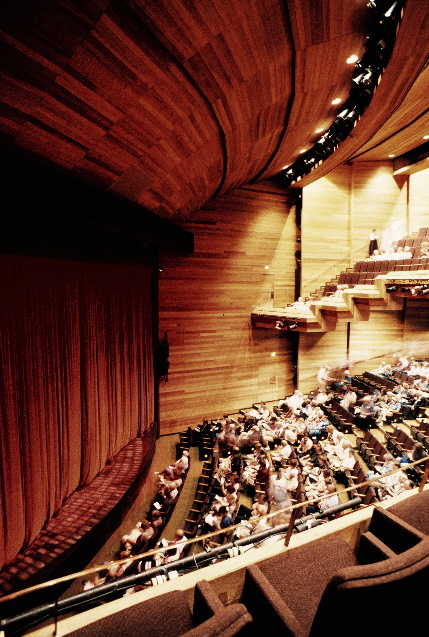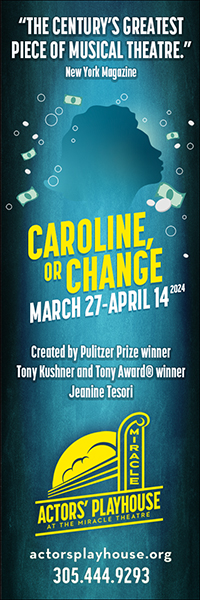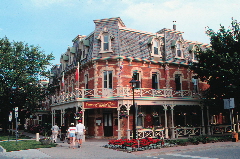
The interior of the Festival Theatre, one of four venues at the Shaw Festival in Niagara-on-the-Lake / Photo by Andrée Lanthier
By Bill Hirschman
If someone was designing a heaven on earth for theater lovers, they might not have to go farther for a blueprint than the Shaw Festival in Niagara-on-the-Lake in early summer.
And if anyone was looking for a concrete refutation that theater is a dying art form economically and popularly, they should note the nearly-full houses at Festival performances and the thousands of theatergoers of every age and ethnicity strolling the downtown business district.
Shaw Festival main page: http://www.shawfest.com/
Niagara-on-the-Lake brochure: http://tinyurl.com/pjjsdfq
The Festival has had to overcome a rocky financial period like nearly every other arts endeavor in North America, and the host city – among the most charming small towns on the continent – has its minor woes such as power blackouts. But there’s a pervading sense that everyone is trying to retool for the 21st Century while maintaining a 19th Century aura – The Festival welcomes a new executive director this fall and its longtime artistic director Maxwell ends her 14-year tenure with the next season.
Yet the Festival sagely remains what it has been much of its 53-year history: a well-funded professional repertory theater company operating much of the year with a large and diverse array of plays and other programs sharing a commitment to imaginatively exploring classic works while trying out contemporary works and even commissioning new works.
The Festival was created in 1962 to revive works specifically by the legendary writer and philosophical provocateur George Bernard Shaw. But those boundaries felt limiting, so the Festival especially under Maxwell “elasticized” its mission, she said. First, the Festival embraced works of Shaw’s contemporaries, a significant swath since he lived from 1856 to 1950. Finally, they decided to mount plays of any period so long as they reflected Shaw’s progressive belief system which resonates all the more loudly in this century.
This season’s works – all sharing a theme of women’s empowerment – encompass Shaw’s classic Pygmalion, Caryl Churchill’s convention shattering Top Girls of the 1980s, the recent Broadway hit Peter and the Starcatcher, Ibsen, Barrie, even Tony Kushner. (To read our reviews and its lessons for South Florida mentality, click here) The works also share fine-tuned performances, unique directorial visions and full-throated production values for even the most modest undertakings.
The on stage productions are only one facet off the menu of attractions: seminars, pre-show and post-show talkbacks, lectures, youth programs, meet-and-greets with playwrights, workshops on everything from accents to how to be a stage manager, singalongs tied to the season’s musical, dinners at wineries, and, most notably a tour in, around and even under the main Festival stage while the crew is changing the scenery and props from one show to another.
But it’s the reliable quality of the work that lands with audiences and keeps them returning. In an interview this summer, Maxwell said, “I have four spaces in which I can program plays that no one has ever heard of and actually have people come because there’s a level of trust and a level of curiosity.”
Tickets are not cheap: Some single tickets are as low as $35 in Canadian dollars, others can top $116, but there are discounts for student and seniors at matinees, season passes, previews, children’s tickets, three-show packages and discounts for booking early, especially for the slower season in September,.
The company operates four venues: the Festival Theatre, a 856-seat auditorium built in 1973; the Court House Theatre, an intimate 327-seat thrust stage with arena tiered seating commanding the top floor of an 1840s stone structure downtown; the new Studio Theatre with 194-seats adjacent to the Festival Theatre, and the Royal George Theatre, a 313-seat jewel box downtown converted from a 1915 vaudeville house. Its infrastructure includes a warehouse with 30,000 costumes and thousands of props dating back to the start if the Festival.
The continent-wide recession damaged the Festivals’ finances and attendance, especially the discretionary tourism the Shaw relies on. But Maxwell and company have worked hard to rebuild, resulting in three consecutive seasons with a surplus.
“That really helps calm things down, but this (arts economy) climate is always tricky. You never relax, but at least it’s a solid base. I really want the two new people coming in here to have a fighting chance,” she said.
It has enabled the Festival to plan for the future including a new theater building because the Court House is rented space moved into for only part of the year, and the Royal George is cramped with no lobby.
The Festival is a major seasonal economic engine for the region with a $28.6 million annual budget in Canadian dollars and an estimated $70-$100 million impact on the region. It sells about a quarter-million tickets annually — about a third to patrons from the United States. The 600-700 employee payroll contains artists and craftsmen through the bulk of the season and a crew of administrators, clerical staff, groundskeepers and the like year-round, plus an army of unpaid volunteers.
The acting troupe of about 70 people includes interns, newcomers and veterans who return year after year, drawn by the decidedly ensemble nature of most of the works and the ethos of the company. The program bio of Peter Millard of You Never Can Tell cites 55 productions over 29 seasons. Almost all are Canadians with unusually polished skills who work elsewhere across the country and sometimes in northern U.S. cities like Chicago. “We have bench strength,” Maxwell quips. Some multi-talented people act and direct in the same or subsequent seasons. The Shaw offers continuing training for the professionals and interns during their stay. Since the schedule slips show in and out of the mix every few weeks, some actors show up in January and some don’t leave until November. But virtually everyone plays at least two roles during the season, demonstrating the kind of range that Maxwell calls bi-polar. The parlor maid on The Twelve-Pound Look is played by Harveen Sandhu who was Liza in Pygmalion the night before.
Its scope in every area is somewhat more modest compared the older, better-financed grande dame Stratford Shakespeare Festival. But there’s a more laid back sense like an amiable stroll tinged with intimacy and manageability suffusing the experience.
A Sylvan Setting
That flows to some degree from its location. If the Festival is the gem, it’s the picturesque ambience of Niagara-on-the-Lake that seals the deal.
The town of 15,000 sits where the gorgeous Niagara River flows into Lake Ontario. The destination is about a 50-minute drive directly north of Buffalo, 20-30 minutes north of Niagara Falls, 2 hours southwest of Toronto and a 2 ½ hour drive from Stratford.
 While the town was founded in the 1700s, much of it was destroyed by we Americans during the War of 1812. They don’t seem to hold a grudge. Just bring dollars. As a result, the town’s older buildings date back to reconstruction during the mid-1800s. What’s been built since, especially in the past 60 years has labored to maintain that feeling.
While the town was founded in the 1700s, much of it was destroyed by we Americans during the War of 1812. They don’t seem to hold a grudge. Just bring dollars. As a result, the town’s older buildings date back to reconstruction during the mid-1800s. What’s been built since, especially in the past 60 years has labored to maintain that feeling.
The city council must spend a large percentage of its budget on immaculate landscaping that makes the entire town feel like a turn-of-the-century park. The smell of hundreds of well-cultivated but rioting flower beds are sometimes overcome from the wafting aroma of an ice cream parlor.
The gentle bucolic pace is reinforced by the fact that most people walk everywhere. Others use Segways, scooters and even bicycles to traverse the town, venture into wine country or explore miles of paths along the river.
With the Festival’s main theater on the east side of town, the rest stretches a few blocks north and south along eight blocks or so of Queen Street. That main drag is lined with quaint galleries, bakeries, restaurants and stores selling gifts, books, ice wines, art and fashions. Nearly everyone will ship across the border, except for wine.
The region’s unannounced industry is tourist housing with several show-and-hotel packages offered through the Festival. The area is dotted with small hotels, country inns, bed & breakfasts, rental properties, and luxury hotels like the glorious Prince of Wales. This collection of three adjacent hotels centers on the structure built in 1864, expanded since 1975 and thoroughly renovated in 1988. It combines Victorian décor dominates virtually every square foot, but has most conveniences of a modern hotel secreted away. The price is a bit steep but it’s a luxurious experience. In fact, it’s a tourist town and everything from food to tchokes is a tad higher than you expect.
Aside from the wineries and a few tourist oddities, the Festival and the town’s shopping district are the primary attractions. But across the street from the Festival’s headquarters is a sprawling recreation of the 200-year-old Fort George where costumed characters roam, including a fife and drum corps.
The region between Niagara Falls and Niagara-on-the-Lake is a sleepy agricultural expanse dotted by dozens of wineries – family and corporate — that encourage you stop off for tastings and tours. While you can take the Queen Elizabeth Way highway to the town from the breathtaking natural wonder of the world, a much better drive is up the tree-lined Niagara Parkway that follows the curving Niagara, and features turnoffs to soak in the views.
And you can and should drop down to see the Falls; there’s two or three days of attractions right there. By the way, most of the best views and attractions are on the Canada side, especially if you are going to book a hotel with a window facing the falls (pricey). No matter what, book a ride on either the Maid of the Mist boat on the U.S. side or its Canadian brother the Hornblower. It’s a once in a lifetime close-up soaking from the two falls (buy tickets online in advance and skip the long lines).
To see a PBS video about the festival, click here.
* Alice in Wonderland: The world premiere of a new version adapted by
Peter Hinton will be set in the Victorian world of Oxford and use a dazzling combination of contemporary technology and old-fashioned magic.
* A Woman of No Importance by Oscar Wilde (1893): Mrs. Arbuthnot has long held a secret. But when her son is appointed secretary for the charismatic Lord Illingworth, it may not be secret for much longer. With a party at a country home as the backdrop, Oscar Wilde’s comedy explores the social masks men and women wear, and the double standards of aristocratic society.
* Sweeney Todd, The Demon Barber of Fleet Street: One of Stephen Sondheim’s masterpieces. ‘Nuf said.
* Uncle Vanya, by Anton Chekhov (1989): Artistic Director Jackie Maxwell’s swan song will be this timeless exploration of the many twists and absurdities of unfulfilled love. A new version of the play is currently under discussion.
* Mrs. Warren’s Profession, by George Bernard Shaw (1893): A love story… between a mother and a daughter. Young up-and-coming Vivie comes home to become acquainted with her mother, but is shocked to discover the source of the family’s wealth, prostitution. Shaw criticizes social convention and sexual hypocrisy with his trademark wit as two strong-willed women attempt to build a relationship.
* “Master Harold”… and the Boys, by Athol Fugard (1982): In this coming of age story set in South Africa during the apartheid era, Harold, a white teenaged boy, grows up in the company of the two black waiters who work in his mother’s tea room. When he learns his tyrannical and racist father is returning home, Harold succumbs to the cultural hatred fostered by apartheid, costing him and his friends dearly.
* Our Town, by Thornton Wilder (1938): You know this one.
* Engaged, An Entirely Original Farcical Comedy in Three Acts, (1877) by W.S. Gilbert: Gilbert before Sullivan. In this rarely produced romantic romp, an English train is gently hijacked in the Scottish countryside with hilarious results. There are love triangles, suitors pursuing each other across the country and a man who falls in love with every woman he meets. Love will conquer all… as long as the coin purse is full.
* The Adventures of the Black Girl in Her Search for God, adapted for the stage by Lisa Codrington from a short story by Shaw: This premiere commissioned by the Shaw Festival centers on a young African girl who embarks on a journey to find her own God, being unfulfilled by the teachings from white missionaries. In this allegory, she encounters a number of Gods, each of whom try to convert her to their way of thinking. The original novella by Bernard Shaw, published in 1932, was met with public outcry labelling the author as a blasphemer.
* The Dance of Death, by August Strindberg in a new version by Richard Greenberg: A drama exploring marriage featuring bravura roles. Alice and Edgar are approaching their 25th anniversary. They’re socially isolated and have alienated their children. All they have now is the mutual hatred that binds them together – unhappily ever after. The Dance of Death was the first naturalistic portrait of a marriage in modern drama, paving the way for plays such as Who’s Afraid of Virginia Woolf?
Tickets for the Shaw Festival’s 2016 Season will go on sale tickets this fall.









 A PaperStreet Web Design
A PaperStreet Web Design
